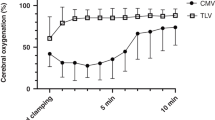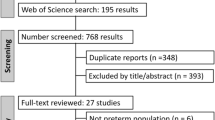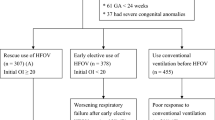Abstract
Objective:
Clara cell 16 kD protein (CC16) and interleukin (IL)-6 have been used as peripheral blood biomarkers of alveolar leakage and inflammation, respectively. Thus, their measurement in the bloodstream could be used to assess ventilator-induced lung injury. The objective of this study was to evaluate the effect of optimized synchronized intermittent mandatory ventilation (SIMV) and high-frequency oscillatory ventilation (HFOV) on circulating CC16 and IL-6 levels when used as the initial ventilation modes in preterm neonates.
Study Design:
Single center, prospective, randomized clinical study in preterm neonates (gestational age ⩽30 weeks) requiring mechanical ventilation within the first 2 h of life. Serum CC16 and IL-6 were measured on establishment of the assigned ventilation mode after admission, at days 3 and 14 of life as well as at 36 weeks postmenstrual age. Demographic-perinatal data and clinical parameters were also recorded.
Result:
Of the 30 neonates studied, 24 (gestational age 27.1±1.7 weeks, birth weight 942±214 g) were finally analyzed, equally assigned into the SIMV and HFOV groups. Both groups had comparable demographic-perinatal characteristics and clinical parameters. Serum CC16 and IL-6 altered significantly over time (repeated-measures analysis of variance, both P<0.001). However, changes were not affected by the ventilation mode. Post hoc analysis showed a significant decrease in CC16 and IL-6 from birth up to 36 weeks postmenstrual age in both groups.
Conclusion:
In preterm neonates, SIMV and HFOV are associated with comparable circulating CC16 and IL-6 levels. These findings suggest a similar alveolar leakage and systemic inflammation with any of the ventilation modes evaluated when their usage is optimized.
This is a preview of subscription content, access via your institution
Access options
Subscribe to this journal
Receive 12 print issues and online access
$259.00 per year
only $21.58 per issue
Buy this article
- Purchase on Springer Link
- Instant access to full article PDF
Prices may be subject to local taxes which are calculated during checkout



Similar content being viewed by others
References
Smith VC, Zupancic JA, McCormick MC, Croen LA, Greene J, Escobar GJ et al. Trends in severe bronchopulmonary dysplasia rates between 1994 and 2002. J Pediatr 2005; 146 (4): 469–473.
Jackson JC, Truog WE, Standaert TA, Juul SE, Murphy JH, Chi EY et al. Effect of high frequency ventilation on the development of alveolar edema in premature monkeys at risk for hyaline membrane disease. Am Rev Respir Dis 1991; 143 (4): 865–871.
Yoder BA, Siler-Khodr T, Winter VT, Coalson JJ . High-frequency oscillatory ventilation: effects on lung function, mechanics, and airway cytokines in the immature baboon model for neonatal chronic lung disease. Am J Respir Crit Care Med 2000; 162 (5): 1867–1876.
Bollen CW, Uiterwaal CS, van Vught AJ . Meta-regression analysis of high-frequency ventilation vs conventional ventilation in infant respiratory distress syndrome. Intensive Care Med 2007; 33 (4): 680–688.
Cools F, Henderson-Smart DJ, Offringa M, Askie LM . Elective high frequency oscillatory ventilation versus conventional ventilation for acute pulmonary dysfunction in preterm infants. Cochrane Database Syst Rev 2009; (3): CD000104.
Thome U, Götze-Speer B, Speer CP, Pohlandt F . Comparison of pulmonary inflammatory mediators in preterm infants treated with intermittent positive pressure ventilation or high frequency oscillatory ventilation. Pediatr Res 1998; 44 (3): 330–337.
Capoluongo E, Vento G, Santonocito C, Matassa PG, Vaccarella C, Giardina B et al. Comparison of serum levels of seven cytokines in premature newborns undergoing different ventilatory procedures: high frequency oscillatory ventilation or synchronized intermittent mandatory ventilation. Eur Cytokine Netw 2005; 16 (3): 199–205.
Vento G, Capoluongo E, Matassa PG, Concolino P, Vendettuoli V, Vaccarella C et al. Serum levels of seven cytokines in premature ventilated newborns: correlations with old and new forms of bronchopulmonary dysplasia. Intensive Care Med 2006; 32 (5): 723–730.
Doyle IR, Hermans C, Bernard A, Nicholas TE, Bersten AD . Clearance of Clara cell secretory protein 16 (CC16) and surfactant proteins A and B from blood in acute respiratory failure. Am J Respir Crit Care Med 1998; 158 (5): 1528–1535.
Hermans C, Petrek M, Kolek V, Weynand B, Pieters T, Lambert M et al. Serum Clara cell protein (CC16), a marker of the integrity of the air-blood barrier in sarcoidosis. Eur Respir J 2001; 18 (3): 507–514.
Lesur O, Langevin S, Berthiaume Y, Legare M, Skrobik Y, Bellemare JF et al. Outcome value of Clara cell protein in serum of patients with acute respiratory distress syndrome. Intensive Care Med 2006; 32 (8): 1167–1174.
Martin AC, Laing IA, Khoo SK, Zhang G, Rueter K, Teoh L et al. Acute asthma in children: relationships among CD14 and CC16 genotypes, plasma levels, and severity. Am J Respir Crit Care Med 2006; 173 (6): 617–622.
Loughran-Fowlds A, Oei J, Wang H, Xu H, Wimalasundera N, Egan C et al. The influence of gestation and mechanical ventilation on serum clara cell secretory protein (CC10) concentrations in ventilated and nonventilated newborn infants. Pediatr Res 2006; 60 (1): 103–108.
Sarafidis K, Stathopoulou T, Diamanti E, Soubasi V, Agakidis C, Balaska A et al. Clara cell secretory protein (CC16) as a peripheral blood biomarker of lung injury in ventilated preterm neonates. Eur J Pediatr 2008; 167 (11): 1297–1303.
Hermans C, Bernard A . Lung epithelium-specific proteins: characteristics and potential applications as markers. Am J Respir Crit Care Med 1999; 159 (2): 646–678.
Miller LC, Isa S, LoPreste G, Schaller JG, Dinarello CA . Neonatal interleukin-1 beta, interleukin-6, and tumor necrosis factor: cord blood levels and cellular production. J Pediatr 1990; 117 (6): 961–965.
Chiesa C, Pellegrini G, Panero A, Osborn JF, Signore F, Assumma M et al. C-reactive protein, interleukin-6, and procalcitonin in the immediate postnatal period: influence of illness severity, risk status, antenatal and perinatal complications, and infection. Clin Chem 2003; 49 (1): 60–68.
Ambalavanan N, Carlo WA . Ventilatory strategies in the prevention and management of bronchopulmonary dysplasia. Semin Perinatol 2006; 30 (4): 192–199.
Papile L, Burstein J, Burstein R, Koffler H . Incidence and evolution of subependymal and intraventricular hemorrhage: a study of infants with birth weights less than 1500. J Pediatr 1978; 92 (4): 529–534.
Jobe AH, Bancalari E . Bronchopulmonary dysplasia. Am J Respir Crit Care Med 2001; 163 (7): 1723–1729.
Arsalane K, Broeckaert F, Knoops B, Wiedig M, Toubeau G, Bernard A . Clara cell specific protein (CC16) expression after acute lung inflammation induced by intratracheal lipopolysaccharide administration. Am J Respir Crit Care Med 2000; 161 (5): 1624–1630.
Dreyfuss D, Saumon G . Ventilator-induced lung injury: lessons from experimental studies. Am J Respir Crit Care Med 1998; 157 (1): 294–323.
Tamura M, Kawano T, Fitz-James I, Bryan AC . High-frequency oscillatory ventilation and pulmonary extravascular water. Anesth Analg 1985; 64 (11): 1041–1046.
Schrama AJ, Bernard A, Poorthuis BJ, Zwinderman AH, Berger HM, Walther FJ . Cord blood Clara cell protein CC16 predicts the development of bronchopulmonary dysplasia. Eur J Pediatr 2008; 167 (11): 1305–1312.
Michel O, Murdoch R, Bernard A . Inhaled LPS induces blood release of Clara cell specific protein (CC16) in human beings. J Allergy Clin Immunol 2005; 115 (6): 1143–1147.
Lassus P, Nevalainen TJ, Eskola JU, Andersson S . Clara-cell secretory protein in preterm infants’ tracheal aspirates correlates with maturity and increases in infection. Pediatr Pulmonol 2000; 30 (6): 466–469.
Thomas W, Seidenspinner S, Kawczyńska-Leda N, Chmielnicka-Kopaczyk M, Marx A, Wirbelauer J et al. Clara cell secretory protein in tracheobronchial aspirates and umbilical cord serum of extremely premature infants with systemic inflammation. Neonatology 2010; 97: 228–234.
Gotsch F, Romero R, Kusanovic JP, Mazaki-Tovi S, Pineles BL, Erez O et al. The fetal inflammatory response syndrome. Clin Obstet Gynecol 2007; 50 (3): 652–683.
Stüber F, Wrigge H, Schroeder S, Wetegrove S, Zinserling J, Hoeft A et al. Kinetic and reversibility of mechanical ventilation-associated pulmonary and systemic inflammatory response in patients with acute lung injury. Intensive Care Med 2002; 28 (7): 834–841.
Jaarsma AS, Braaksma MA, Geven WB, Van Oeveren W, Oetomo SB . Early activation of inflammation and clotting in the preterm lamb with neonatal RDS: comparison of conventional ventilation and high frequency oscillatory ventilation. Pediatr Res 2001; 50 (5): 650–657.
Ng PC, Cheng SH, Chui KM, Fok TF, Wong MY, Wong W et al. Diagnosis of late onset neonatal sepsis with cytokines, adhesion molecule, and C-reactive protein in preterm very low birth weight infants. Arch Dis Child Fetal Neonatal Ed 1997; 77 (3): F221–F227.
Cepkova M, Brady S, Sapru A, Matthay MA, Church G . Biological markers of lung injury before and after the institution of positive pressure ventilation in patients with acute lung injury. Crit Care 2006; 10 (5): R126.
Van Reempts P, Borstlap C, Laroche S, Van der Auwera JC . Early use of high frequency ventilation in the premature neonate. Eur J Pediatr 2003; 162 (4): 219–226.
Krishnan RK, Meyers PA, Worwa C, Goertz R, Schauer G, Mammel MC . Standardized lung recruitment during high frequency and conventional ventilation: similar pathophysiologic and inflammatory responses in an animal model of respiratory distress syndrome. Intensive Care Med 2004; 30 (6): 1195–1203.
Levine CR, Gewolb IH, Allen K, Welch RW, Melby JM, Pollack S et al. The safety, pharmacokinetics, and anti-inflammatory effects of intratracheal recombinant human Clara cell protein in premature infants with respiratory distress syndrome. Pediatr Res 2005; 58 (1): 15–21.
Acknowledgements
We thank Dr Christos Nakas for his assistance in statistical analysis of this paper.
Author information
Authors and Affiliations
Corresponding author
Ethics declarations
Competing interests
The authors declare no conflict of interest.
Rights and permissions
About this article
Cite this article
Sarafidis, K., Stathopoulou, T., Agakidou, E. et al. Comparable effect of conventional ventilation versus early high-frequency oscillation on serum CC16 and IL-6 levels in preterm neonates. J Perinatol 31, 104–111 (2011). https://doi.org/10.1038/jp.2010.78
Received:
Revised:
Accepted:
Published:
Issue Date:
DOI: https://doi.org/10.1038/jp.2010.78
Keywords
This article is cited by
-
Receipt of high-frequency ventilation is associated with acute kidney injury in very preterm neonates
Pediatric Nephrology (2024)
-
Renal dysfunction reduces the diagnostic and prognostic value of serum CC16 for acute respiratory distress syndrome in intensive care patients
BMC Pulmonary Medicine (2020)
-
Correlation of serum KL-6 and CC16 levels with neurodevelopmental outcome in premature infants at 12 months corrected age
Scientific Reports (2015)



